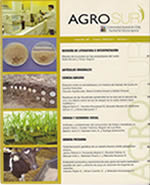Concentración de carbohidratos solubles en agua y nitrógeno posterior a la defoliación en ballicas perennes (Lolium perenne L.) en primavera
Contenido principal del artículo
Resumen
Se encuentra bien documentado que los carbohidratos solubles en agua (CSA) y nitrógeno (N) son fuentes para iniciar el rebrote posterior a la defoliación, pero hay poca información sobre sus cambios cuando cultivares normales, o comercializados por mayores niveles de azúcar son usados bajo condiciones de campo. El objetivo del estudio fue evaluar, cada tres días, la concentración de CSA y N en el residuo y el rebrote de cuatro ballicas perennes (AberAvon, AberDart AR1, Arrow AR1 y Jumbo). No se registraron interacciones entre cultivares y el tiempo posterior a la defoliación en la concentración de CSA y N para cada uno de los tejidos (p > 0.05). Hubo efectos del tiempo post-defoliación en ambos tejidos (p < 0.05). En el residuo, la concentración de CSA disminuyó hasta el día nueve post-defoliación (148.9 g kg-1 MS) con una recuperación a los niveles iniciales en el día 18 (198.8 g kg-1 MS). En el rebrote, estos valores cambiaron desde 114.4 a 159.5 g kg-1 MS respectivamente. La concentración de N en el residuo y en el rebrote aumentó hasta el día 9 (26.4 g kg-1 MS) y día 12 (38.2 g kg-1 MS) respectivamente. Posteriormente, una disminución constante hasta el final del periodo ocurrió, con una concentración de N de 20.4 y 27.8 g kg-1 MS para el residuo y el rebrote respectivamente. Los resultados indican que el uso de cultivares comercializados como altos en azúcar no confieren una ventaja en relación a mayores porcentajes de CSA en distintos tejidos posterior a la defoliación.

